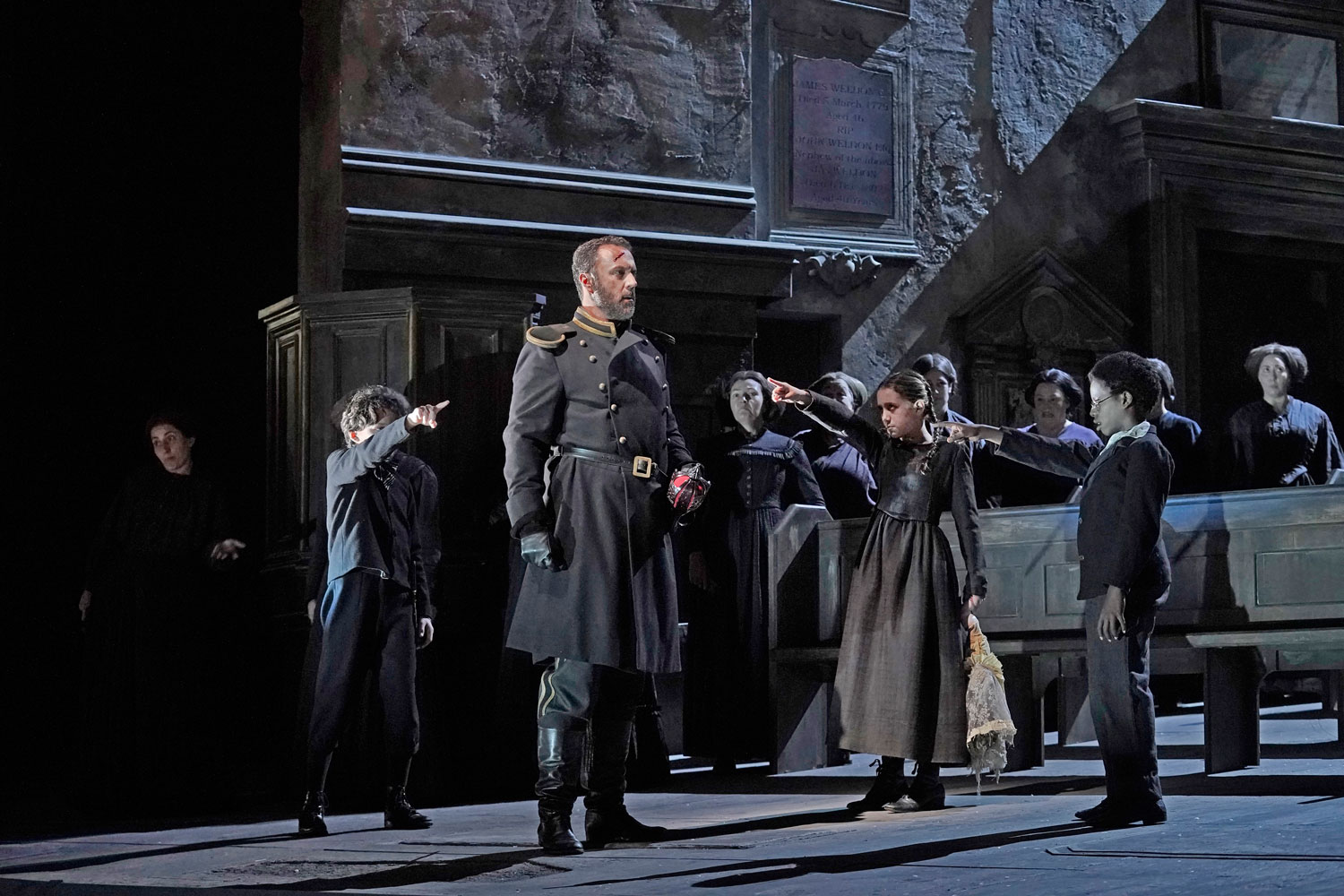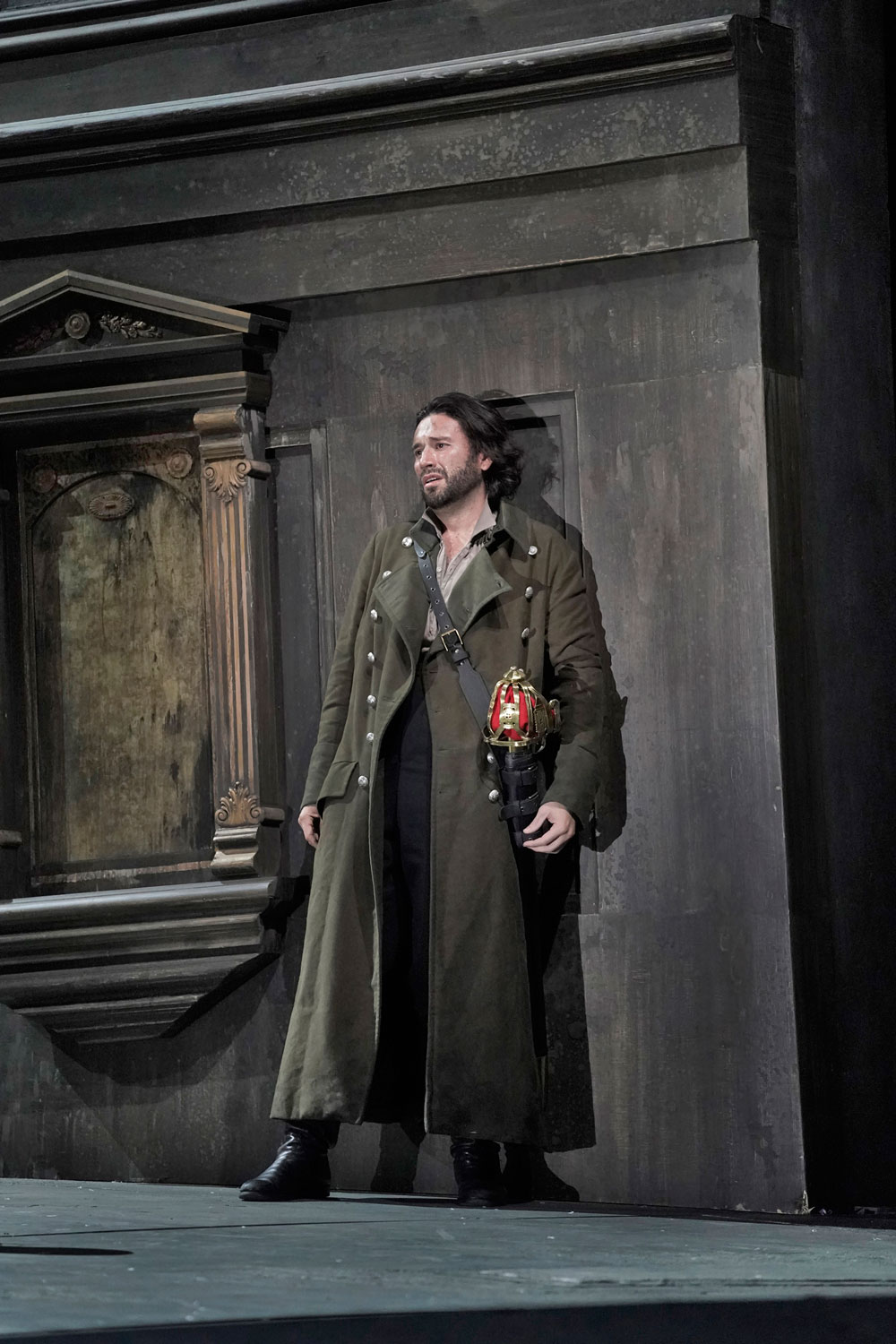With a new production by Sir David McVicar of Giueppe Verdi’s Macbeth Lyric Opera of Chicago has opened its new season and recommenced live performances on stage with audience. In the title role, Craig Colclough makes his debut at Lyric Opera while Sondra Radvanovsky performs the role of Lady Macbeth. Banquo and Macduff are sung by Christian Van Horn and Joshua Guerrero, the latter also in a debut role at Lyric Opera. The characters of Malcolm, Lady in Waiting, and the doctor are performed by Matthew Vickers, Mathilda Edge, and Rivers Hawkins. Anthony Reed sings the roles of both the assassin and first apparition. The Lyric Opera Orchestra is conducted by Enrique Mazzola and the Lyric Opera Chorus is prepared by Michael Black. The set designs are by David Macfarlane, costumes are by Moritz Junge, and the lighting designer is David Finn.

In many ways, the depictions presented by the two protagonists are determined by the dictates of this production while they, at the same time, combine such interpretations with a vision of Verdi’s score. In this conception of the drama McVicar sets the action in “a ruined Presbyterian chapel” during the second half of the nineteenth century. This timing is also intended to approximate the revised, second version of Verdi’s score which is used in the current production. Since the chapel will figure in all scenes of the opera, clever use is made of the locale from the very start. In the first scene, three groups of witches appear dressed in Victorian black gowns and seated in the chapel’s pews, as though parishioners, rather than being positioned on the accustomed barren heath. The solid preparation of the female chorus contributes to the effect of the witches’ statements when they confront Macbeth and Banquo. The voices of Messrs. Colclough and Van Horm reflect here their characters’ personalities as they ponder differently on the witches’ pronouncements. Colclough is introspective rather than full-voiced, with a grainy texture on some lines in his aria to indicate his internal struggles; Van Horn’s voice is open and frank as he comments to himself “l’inferno il ver parlò” [“the devil indeed speaks true”]. This ensemble with the scenic function of capturing both good and the temptation of evil within a limited space of the chapel brings focus to the complexity of Macbeth’s persona. The second scene showcases Lady Macbeth, again in this environment yet with a contrasting approach. In keeping with the score, much of her first aria is sung as an urgent appeal. Here Ms. Radvanovsky moves from reading in hushed tones the letter sent by Macbeth to dramatically lyrical outbursts while conjuring help from the “ministri infernali.” With gradually increasing decoration in both parts of her aria Radvanovsky muses first on Macbeth’s potential and ultimately on the need for violent action to promote mutual ambition. As she kneels and waves her arms to summon the spirits, Lady Macbeth’s determination remains unquestioned. So too here the conclusion of the aria which rises to a crescendo of shattering forte pitches. Macbeth’s return is followed by hasty, violent plans for the imminent visit by King Duncan. In this production, the King’s retinue proceeds through the chapel and into chambers marked by doors at stage rear. Upon the discovery of Duncan’s murder, all file back into the chapel and denounce the deed. In this choral appeal for divine punishment on sacred ground Lady Macbeth’s top notes ring out in dramatic hypocrisy.

In the second act inspiration for a second murder is invoked in an appropriately lilting approach by Radvanovsky in Lady Macbeth’s appeal, “La luce langue” [‘The light wanes”]. She coaxes gradually a hesitant Macbeth with vocal insistence ranging through multiple shades of emphasis. The scene culminating in Banquo’s murder is effectively staged so that the assassins lurk along the back wall of the chapel. In his address confiding foreboding to his son Mr. Van Horn delivers a vocal performance of tragic greatness. In his touching emphasis on King Duncan as his sovereign, Van Horn weaves with assured legato the role of memory with the horror of murder. The rising pitch of his final statement “di terror” seems to hang in the air for moments until the assassins make their move.
From the final scene in Act Two until the close of the opera modifications are made to adapt the interior of the chapel to individual topics or shifting venues. In the banquet scene, for example, a simple transformation of décor adds tables and pertinent lighting in order to welcome the invited guests. In his reaction to the intermittent appearance of Banquo’s ghost, Colclough retreats into himself causing Lady Macbeth to invite distraction in her renowned drinking song. In “Si colmi il calice” [“Fill the goblet to the brim”] Radvanovsky uses a lighter, more lyrical approach than in the earlier pieces, here with top notes integrated into a logical musical line. Further adjustments of the set are required to approximate the witches’ cave in the following act. For the first time, at least a portion of the walls seems to remain open to accommodate apparitions and the prophecies of Macbeth’s future. Perhaps most innovative is the transformation of the chapel at the start of Act Four into the borderland between Scotland and England where Macduff morns his family while consoling the Scottish refugees. Lighting, costumes, and gestures suggest the pitiful state of the exiles. After the moving choral lament on the loss of homeland Macduff sings of his slain family and his wish to face the tyrant. In his performance of this aria, Mr. Guerrero is unforgettable. His tracing of emotions through unbroken lines of lyricism glows as an inspiration to console the others. As Macduff’s determination to fight on concludes the aria, Guerrero’s pitches gain intensity while never losing the rounded beauty of his supple approach. The lines “Trammi al tiranno in faccia, Signore!” [“Bring me face to face with the tyrant, O Lord!”] Guerrero concludes with a heroic appeal to face his sworn enemy. The opportunity is indeed yielded him as the back wall of the chapel opens out onto the crucial battlefield and the chapel is overrun with fighters. Ironically, Macbeth’s final determination assures his continued belief in his rectitude, here emphasized by Colclough’s heroic tone in his character’s final aria. Despite this last effort, Macduff is granted his prayer before the final victorious chorus.
Salvatore Calomino
Above: Sondra Radvanovsky as Lady Macbeth and Craig Colclough as Macbeth
All photos by Ken Howard courtesy of Chicago Lyric Opera